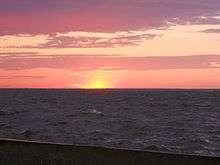Great South Bay

Great South Bay, actually a lagoon,[1] is situated between Long Island and Fire Island, in the State of New York. It is approximately 45 miles (72 km) long and protected from the Atlantic Ocean by Fire Island, a barrier island, as well as the eastern end of Jones Beach Island and Captree Island.
Robert Moses Causeway adjoins the Great South Bay Bridge, which leads to Robert Moses State Park.

The bay is accessible from the ocean through Fire Island Inlet, which lies between the western tip of Fire Island and the eastern tip of Jones Beach Island. The bay adjoins South Oyster Bay on its western end, and Patchogue and Moriches bays at the east end.
History
In the early 17th century, European settlers first encountered the native Meroke tribes. Among the earliest British families were the Smith, Carman and Hewlett families.[2] Long Island's South Shore, which includes Lindenhurst, Babylon, Islip, Oakdale, Sayville, Bayport, Blue Point, Patchogue, Bellport, Shirley, and Mastic Beach.
Environmental concerns

In the late nineteenth century Great South Bay provided many of the clams consumed throughout the region and even the country. The first oysters to be exported from the US to Europe came from Great South Bay. By the latter 20th century, a significant percentage of the habitat was lost.[3] Recently the largest storm on record since 1938, Hurricane Sandy, made landfall with devastating impact to Fire Island sea shores, including multiple breaches. The largest forming just south of Bellport, Long Island. This was formerly known as Old Inlet. Residents were concerned it would have effects on tidal increases and potential flooding, when in actuality it has allowed the bay to relieve some of its captive water, which has changed the salinity and nitrogen levels in the bay.[4] The Bay has, after roughly 75 years, begun flushing itself out which may improve the water condition within the bay.[5] Regulations set forth by the US Government National Wildlife Preserve, which has a seven-mile stretch of land (The Otis Pike Fire Island High Dune Wilderness) prohibit any unauthorized parties from performing any kind of man made changes, thus the inlet has remained open. There have been a number of ongoing public meeting discussing the future of the Inlet.[6] All the other breaches were closed by the Army Corps of Engineers. The Save the Great South Bay not-for-profit organization was formed in order to work towards better conservation of the water and its beachfronts.[7][8]
See also
References
- ↑ Goodbred, Jr., S.; Locicero, P.; Bonvento, V.; Kolbe, S.; Holsinger, S. "History of the Great South Bay estuary: Evidence for a catastrophic origin" (PDF). State University of New York (SUNY.com). Retrieved 2013-10-02.
- ↑ http://freepages.genealogy.rootsweb.com/~carman/hsarch/hsarch2.htm
- ↑ Andrea Schwalm (January 18, 2013). "New Fire Island Breach Could Be Beneficial Unless Government Fills It In". Wired. Retrieved June 29, 2018.
- ↑ Marshall Brown. "What Mother Nature and The New Inlet Can't Do — A Bay in Peril". Save the Great South Bay. Retrieved June 29, 2018.
- ↑ http://www.nps.gov/fiis/naturescience/post-hurricane-sandy-breaches.htm
- ↑ Lisa W. Foderaro (October 3, 2016). "On Fire Island, a Scar From Hurricane Sandy Is Seen as a Good Thing". The New York Times. The New York Times Company. Retrieved June 29, 2018.
- ↑ Will James (November 13, 2013). "On Long Island Coast, An Unexpected Gift From Hurricane Sandy". The Atlantic. Retrieved June 29, 2018.
- ↑ Jason Atkinson (September 20, 2013). "Conservation's Radical Middle". HuffPost. Retrieved June 29, 2018.
External links
| Wikimedia Commons has media related to Great South Bay. |
- Back To Baysics - Great South Bay environmental awareness campaign
- Great South Bay Project
- Peconic Baykeepers The Waterkeeper Alliance Member for the Great South Bay
- NOAA chart 12352
Coordinates: 40°41′25″N 73°06′07″W / 40.69028°N 73.10194°W